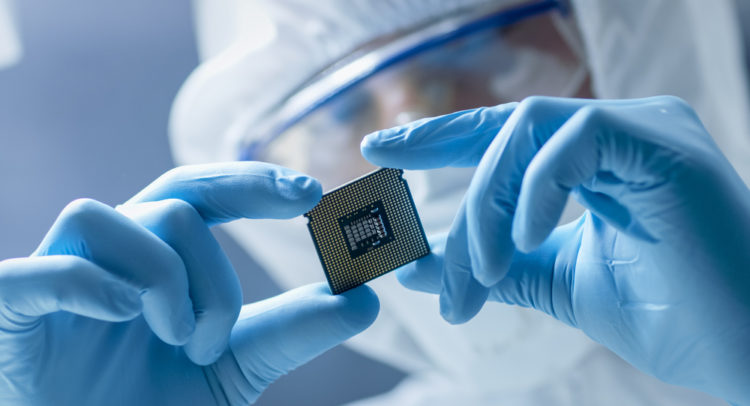Micron Technologies (MU) is a global leader in memory semiconductors, with an impressive portfolio of DRAM and NAND chips. Nvidia (NVDA) and Advance Micro Devices (AMD), who specialize in GPU/CPUs, have rallied dramatically in past years. However, memory leader Micron was left behind in the past year, only to begin a recent three-month rally to multi-decade highs. But after a 35% rally from October 2021, Micron has still underperformed other (non-memory) semiconductor leaders.
Invest with Confidence:
- Follow TipRanks' Top Wall Street Analysts to uncover their success rate and average return.
- Join thousands of data-driven investors – Build your Smart Portfolio for personalized insights.
Recent price action is viewed by many, including myself, as completely justified. Analysts currently have a consensus price target of $359.17. Of the 26 analysts covering Micron, there are 24 Buy ratings, 2 Holds and 0 Sells.

Despite semiconductors’ cyclical nature leading to large earnings swings, I believe Micron still offers a compelling valuation and has yet to hit peak earnings in this cycle.
Micron is positioned very well as an integrated manufacturer, with 12 manufacturing sites globally. The manufacturing process for semiconductors is notoriously specialized and barriers to entry are nearly impossible to overcome, meaning a small number of global semiconductor manufacturers dominate their sub-sectors in the chip market.
If the market demands more chips or a particular industry needs more chips, it’s not as simple as increasing the volume on production lines. Rather, it takes years of careful planning to expand or build new manufacturing sites, which must be completely dust-free and use high cost custom built machinery to fabricate the memory chips. Even the memory chips have a very lengthy manufacturing process, which takes weeks or months from start to finish. Additionally, constant high maintenance CapEx is required to support manufacturing, which is always changing. This is not CapEx used to expand production.
Micron is currently guiding CapEx spend in 2022 to be between $11-12 billion, and a big portion of that is for increased R&D efforts. Furthermore, management said they will commit $150 billion in capital expenditures over the coming decade to increase production capacity. Clearly, Micron will hit a cyclical downturn way before 2030, but it’s in the company’s long-term strategy to build out more sites for future cycles, which will allow Micron to remain competitive during periods of peak profitability.
Micron Yet to Hit Cyclical Peak
Although there is a long-term plan to increase production, this will not affect supply for several years. Essentially, management is increasing supply in anticipation of the serving the longer-term market trend, where more memory chips are needed for automakers, smartphones, computers, 5G infrastructure, artificial Intelligence adoption, etc.
The longer-term tailwind for Micron is that we require more memory. Sectors like automotive still have very high demand for semiconductors, and in December delivery times for car manufacturers increased yet again, due to semiconductor shortages. Lead times are now 25 weeks, up from 22 weeks in October 2021 and 13 weeks in October 2020, according to data from Susquehanna Financial Group.
All major memory suppliers – Samsung, SK Hynix, and Micron, have stated their intentions to tighten supply in order to reduce the cyclical nature of the industry. I do not know to what degree this will work longer term. However, there are no signs of decreasing demand or significant oversupply in the memory market in 2022. Looking at forward guidance, analysts indicate Micron is very far off from a cyclical peak, with revenue expectations of $32.17B and $38.58B in FY22 and FY23 respectively. Additionally, free cash flow is guided by Wall Street to be $4.81B and $7.28B in FY22 and FY23 respectively.
So, although different segments see small fluctuations in demand through the year, such as a drop in enterprise IT, which should improve as workers return to the office – there is no indication that DRAM or NAND demand will see a downtrend in 2022. DRAM overall, which makes up roughly 73% of total revenue, is expected to growth in-line with demand expectations from management, which is around the mid-to-high teens.
Micron has positioned itself as a key market leader with the first 1-alpha node process technology, which can produce DRAM chips that use significantly less power consumption (roughly 20%). Indeed, Micron is part of a memory oligopoly and is even slightly ahead of its memory manufacturing peers.
Balance Sheet and Capital Distribution
Micron has a very healthy balance sheet, with a cash position of $9.58B including equivalents. Therefore, its total debt of $7B could easily be paid off.
Micron has a current ratio of 3.1x and a quick ratio of 2.28x, suggesting it is more than well capitalized, and based on guidance, will likely see further asset growth on the balance sheet going forward. Tangible book value continues to grow, and from a per share perspective, current tangible book value per share is $39.62.
Last year, management decided to begin distributing to shareholders. A very small quarterly dividend of $0.10 per share will be distributed by Micron on the 18th of January and management plans on increasing it slowly over time.
This further demonstrates management’s confidence in future growth, as starting a temporary dividend, only to cut it in the future, will do more damage to investor confidence long term. Furthermore, management wants to repurchase stock to reduce total share count, which should offset dilution from soon-maturing convertible bonds and employee SBC. However, this is an opportunistic buyback policy, meaning if prices continue up into the $100s, management will likely slow down buybacks as the price nudges closer to the stock’s intrinsic value.
Valuation
Micron has a current forward (NTM) EV/EBITDA of 5.27x, meaning that even after the recent rally, Micron’s valuation remains attractive at low multiples. Valuation alone tells investors very little, and specifically, valuation relative to future growth is of much greater importance.
Micron is guided to maintain strong double digit growth for both EBITDA and free cash flow over the next 2 years, indicating that this current valuation of 5.39x EV/EBITDA is still impressive – considering peak profitability has historically been rewarded with a 8-10x multiple by the market. In October last year Micron was being priced at 4x NTM EV/EBITDA; however, even now, after a three month rally, Micron is still being valued like a declining business.
Conclusion
For the above stated reasons, I am bullish on Micron, despite the risk of a cyclical market in the long term. Oil and energy are also cyclical markets; however, long-term returns for best performing oil producers have been very strong. With Micron as a market leader with large barriers to entry, an attractive valuation and longer term tailwind of memory growth should serve to justify upwards price action in 2022.









